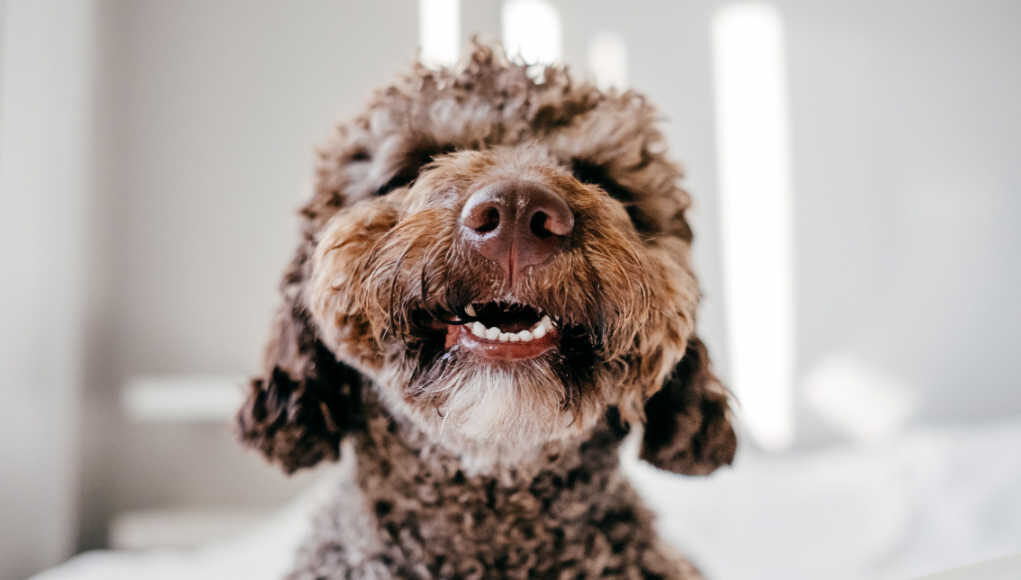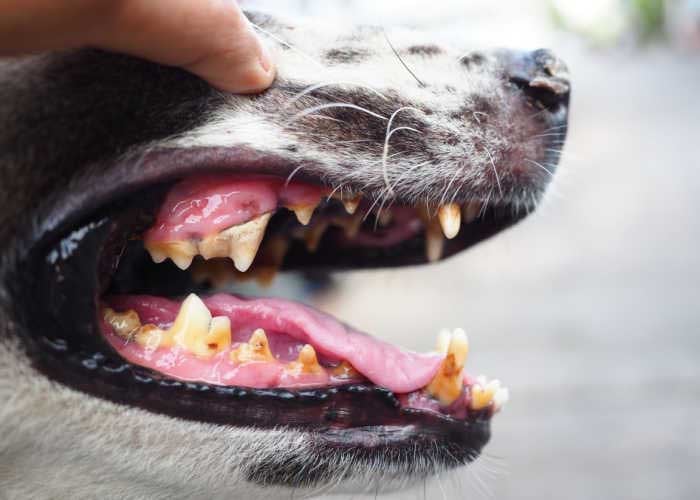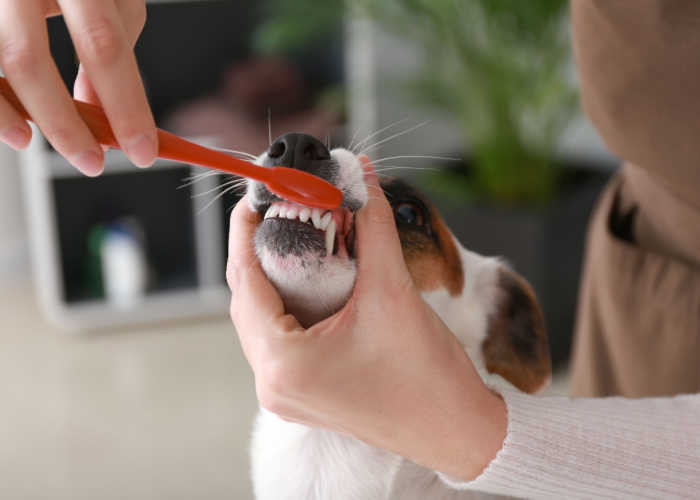Table of Contents
- Rotten Teeth in Dogs
- What Rotten Teeth in Dogs Look Like
- Other Indications of Mouth Pain
- What Causes Rotten Teeth in Dogs
- The Dangers of Rotten Teeth in Dogs
- What To Do with Rotten Teeth in Dogs
- Dog Tooth Cleaning and Extraction
- How to Prevent Rotten Teeth in Dogs
- FAQs about Rotten Teeth in Dogs
- Rotten Teeth in Dogs: Final Thoughts
How common are rotten teeth in dogs?
According to VCA Animal Hospitals, over 80% of dogs are thought to have serious dental health issues since most dog owners don’t take a good look into their dog’s mouths.
It's a good idea to bring your pet in for a visit from time to time since, like humans, they need routine dental cleaning and care.
You can take a few steps to stop tartar from forming on your dog's teeth, such as brushing them with a specific toothpaste and getting the correct chew toys from your neighborhood holistic pet store.
However, it's crucial to recognize the symptoms of dog tooth decay to take action before the problem worsens.
In this article, we look into its causes, how to spot rotten dog teeth, and what you can do to best prevent tooth decay in dogs.
Rotten Teeth in Dogs
Any type of dental illness in dogs can be referred to as having “rotten dog teeth” in a broad, non-technical sense.
However, it typically conjures images of teeth that are painful, discolored, and falling out.
Sadly, our furry friends frequently have rotten teeth. Clearly dogs don't brush their teeth, so they rely on their owners to take care of their dental health.
Fur parents often notice bad breath as one of the first indications of tooth decay in dogs.
Although we don't expect their breath to be particularly pleasant, this does not imply that it should smell rotten.
So, if your pet has bad breath, that could indicate tooth decay due to periodontal disease in dogs.
Also known as dog gum disease, it gradually deteriorates the teeth's supporting tissues brought on by oral bacteria.
RELATED: Gum Infection in Dogs
What Rotten Teeth in Dogs Look Like
Dental illness in dogs hurts, just like it does in people. Besides bad breath, pet owners may also notice chipped, loose, or missing teeth.
Other signs to look for are the following:
Cavities
Sometimes, gaps in your dog's teeth indicate dental caries or cavities. They may appear as large, dark holes or dark spots on the tooth's surface.
Gingivitis
The gums around the teeth will be red and inflamed. The plaque will frequently also be present at the tooth's root if the gums are irritated.
Periodontitis
When gingivitis progresses to periodontitis over time, the gum line will appear to be peeling away from the teeth.
This will result in pockets that might bleed or produce pus. The presence of bleeding gums in your dog may be a sign of this.
Tartar
Tartar, often known as dental calculus, is an accumulation of hardened dental plaque.
The color of this mineral deposit may occasionally be yellow, orange, or brown. It usually appears on the insides of the teeth or along the gum line.
Teeth Discoloration
A yellow or brown discoloration around the gum line of the teeth is a clear sign of plaque and tartar development.
Other Indications of Mouth Pain
Some dogs with rotten teeth will refuse to eat any food, let alone tough meals.
If they decide to consume food, they might only use one side of their mouth to chew.
Due to oral discomfort, it's possible for them to stop playing with their favorite chew toys or to stop playing fetch.
Fur parents may also notice the following symptoms:
Unusual Drooling
Dogs drool when chewing on treats and toys, but when a dog has tooth pain, it may cause him to drool more frequently than usual.
This is because whenever there is pain or injury in the mouth, the salivary glands work extra hard—which occasionally carries the possibility of displaying blood.
Sudden Shyness
If your pet doesn't allow you to touch one side of its face, mouth, or entire head, he may be in discomfort.
The pain may be causing him to act shy for fear that it may hurt him more.
Sneezing and Nasal Discharge
Untreated gum disease may lead to thinning of the bone separating the nasal and oral cavities.
Sneezing and nasal discharge are two indicators that this might have happened. This happens in advanced cases of gum disease in the upper canine teeth.
Swollen Mouth
If you peek into your dog's mouth occasionally, you might be able to see visible changes in your dog’s mouth.
This is something you should frequently do to maintain oral health. As you examine his mouth, you might find lesions on his gums or that one side of his mouth is swollen.
Brittle Teeth
As the dental problem worsens, teeth will become very fragile and eventually fall out.
Rotten teeth leave a pocket when they fall out, where bacteria can grow and continue to hurt.
What Causes Rotten Teeth in Dogs
Numerous reasons can lead to tooth decay in dogs. The most significant ones are poor oral hygiene and dental care.
A dog's chance of developing dental illness is greatly reduced by regularly brushing its teeth with toothpaste approved by its veterinarian.
Still, this routine doesn’t eliminate the risk.
Dogs are more likely to develop tooth decay due to breed genetics and conformation (the structure of the face and mouth).
Breeds with poor dental genetics include Dachshunds and Yorkies. Even daily brushing may not be sufficient to stop oral problems in certain breeds.
Similarly, dogs with brachycephalic (short-faced) characteristics, such as French Bulldogs, Pugs, and Shih Tzus, and those with over- or under-bite (malocclusion), are more likely to have rotten teeth due to their cramped mouths.
Aging itself does not pose a risk. Instead, older dogs tend to show the most obvious signs of years of bad oral hygiene.
The Dangers of Rotten Teeth in Dogs
Dental problems can develop into serious issues that could endanger your dog's entire body and general health if they are not treated.
Here are a few health issues that might arise due to rotten teeth in dogs:
Gum Inflammation
Plaque-related bacteria below the gumline release toxins that harm the surrounding tissues.
Then, white blood cells move into those areas to eradicate the bacteria. Gingivitis, a severe gum infection, is brought on by this mechanism.
The gums become excessively red and puffy due to inflammation, which may bleed when touched.
Heart Disease
Heart disease in dogs is also made more likely by chronic inflammation brought on by periodontal disease.
Bacteria in the bloodstream can result in endocarditis, an inflammatory illness.
According to studies, dogs with dental problems are more likely to develop congestive heart failure, a condition that worsens and can eventually be fatal.
Jaw Fracture
White blood cells' attempts to remove accumulated bacteria result in an inflammatory process that erodes the tooth's supporting tissues.
The jaw bones and tooth sockets eventually become structurally weaker as a result of this deterioration.
Kidney and Liver Disease
Inflammation of the mouth permits bacteria to enter the circulation directly.
Once in circulation, these bacteria can go to and colonize many organs, most notably the liver and kidneys.
Consequences of untreated, canine periodontal disease include organ infection (such as liver or kidney disease) and failure.
Loss of Weight and Appetite
Your dog may experience discomfort or even agony while eating as a result of dental problems.
He could find it difficult to open his jaw and chew his meal thoroughly, which could lead to food spillage.
Over time, your dog's body condition may suffer as a result of his refusal to eat, which could result in weight loss.
Loss of appetite and weight loss may also be signs that a dental condition is creating long-term issues with the liver, heart, and kidneys.
What To Do with Rotten Teeth in Dogs
Treatment for canine tooth decay is identical to that for human cavities.
Using a dental drill, the diseased portion of the tooth is removed, and the defect is then repaired (filled) using composite, a tooth-colored filling material that is light and curing-cured.
Following the right contouring and smoothing of the restoration, a bonding agent is used to seal the restoration's edges.
It may be necessary to pull the tooth if you suspect your dog has rotten teeth, so make an appointment with your veterinarian straight away.
Before taking your dog to your usual veterinarian for a dental operation, you might need to take him to an emergency clinic to start pain medication and antibiotics if he's in a lot of pain.
It is too late to begin brushing your pet's teeth by the time he begins to show signs of tooth decay. There is nothing you can do at home to get rid of the bacteria or fix the rotting teeth.
You can feed your dog a canned or wet food diet until your vet sees him if you suspect oral problems are the reason why he isn't eating dry food.
The pain or infection won't go away, though, even if you change his diet.
Dog Tooth Cleaning and Extraction
Antibiotics won't help rotten teeth recover. So, pay attention to your veterinarian’s advice if they suggest pulling one or more teeth.
Rotten teeth in dogs hurt, and if they are left in the mouth, the surrounding teeth may also develop dental disease.
When performing an extraction, your veterinarian will put your pooch to sleep and use an ultrasonic scaler to remove any calculus on the teeth and the bacteria that has built up on the gums.
Dental x-rays (radiographs) can identify any diseased spots deep within the bones.
The mobility of the tooth, the exposure of the root, and the presence of root infection on dental X-rays all indicate how severe the condition is.
Depending on the tooth in question and the severity of the condition, some extractions are extremely straightforward while others require drilling the tooth out of its socket.
Interestingly, the most difficult teeth to pull are sometimes those that are the most severely decayed.
Following the treatment, your veterinarian will prescribe pain medication and perhaps suggest a soft diet since your dog's mouth will need to recover for a few days.
How to Prevent Rotten Teeth in Dogs
Brushing your dog's teeth daily is the best and most efficient way to stop tooth decay.
Although it may seem difficult, positive reinforcement training using dog-friendly toothpaste and toothbrushes can make it possible.
Never brush your dog's teeth with human toothpaste. Speak to your veterinarian or a nearby dog trainer if you need assistance teaching your dog to accept brushing.
Certain foods, dental chews, and toys can aid in reducing gingivitis and dental tartar. These products are identified by the letters VOHC as a distinctive symbol on their labels.
This is the abbreviation for the Veterinary Oral Health Council, an organization that promotes dental health by using items that have undergone testing.
On the VOHC website, you can find a list of items that are included in various diets designed specifically to help lower the risk of dental disease.
Similarly, hard bones, antlers, and the like can make excellent chew toys, but they can also damage teeth.
As a basic rule of thumb, anything tougher than your fingernail can hurt a dog's teeth. Additionally, it is important to consider the value of routine veterinary checkups.
Your dog's entire set of teeth can be examined by your veterinarian, who is also qualified to spot the early stages of dental illness.
Keeping your dog's mouth healthy is far simpler than treating dental disease after it has already developed—also less unpleasant for your pup and less expensive for you.
FAQs about Rotten Teeth in Dogs
What happens if my dog has rotten teeth?
Rotten dog teeth can have an impact on the whole body in addition to the mouth.
By entering the circulation, the bacteria that surround the tooth root can transmit infection throughout the body.
Are dogs in pain when they have rotten teeth?
Yes, pets experience pain from dental disease.
While gingivitis, an inflammation of the gums, can be painful on its own, certain pets may suffer from more severe conditions like shattered teeth, abscesses at the roots of their teeth, and oral tumors.
What do rotting dog teeth look like?
Gray-brown-green calculus, often known as plaque, is a thick film that coats some rotten teeth.
The premolars and molars in the back of the mouth, where it is most challenging to view, typically suffer from this the worst. But it can also appear on the incisors and canines (front teeth).
Rotten Teeth in Dogs: Final Thoughts
Given that human and dog tooth decay are similar, the American Dental Association defines tooth decay in dogs as “the destruction of tooth enamel, the hard, outer layer of teeth brought on by the plaque, a sticky form of bacteria”.
When enamel breaks down, a hole appears, and more bacteria enter this void or cavity. This then results in tooth deterioration.
It makes sense why we are advised to brush and floss frequently – to prevent plaque and tartar from developing!
Therefore, taking the necessary precautions to safeguard your dog's teeth before symptoms arise is the best approach to maintaining his oral health.
These simple steps, when consistently carried out, can aid in reducing the accumulation of the bacterial film that causes plaque and tartar.
Consult with your veterinarian regarding rotten teeth in dogs if your pooch shows symptoms to prevent further, more serious problems.


















